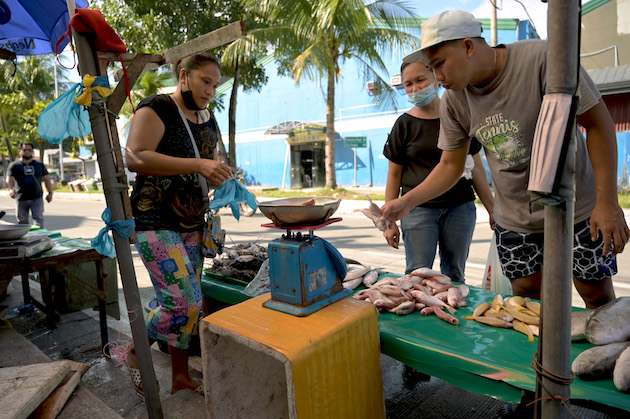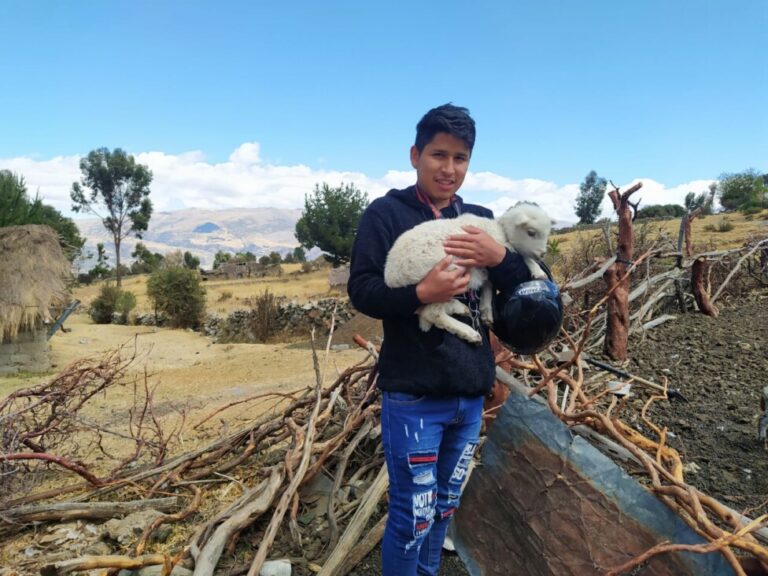
Elvie Gallo’s thriving chicken business means she can support her family and put aside savings to build resilience against future shocks. Credit: BRAC/Robert Irven 2022
By Joyce Chimbi
Iloilo, Philippines, Sep 1 2022 – Elvie Gallo no longer hangs around her local grocery store, hoping for the odd job to put food on the table. Her hand-to-mouth life has been replaced by a viable chicken rearing and selling business in Iloilo province in the Philippines.
“I have enough for today, and I am saving for my children’s future,” she says. Gallo’s story of growth and transformation is replicated across 2,700 households in Iloilo, Bukidnon, and Sultan Kudarat, three of the poorest provinces in the country.
These households have been reached through the Padayon Sustainable Livelihood program (Padayon SLP). This is a capability-building program for households and communities living in extreme poverty to improve their socio-economic conditions and develop thriving livelihoods. The Padayon SLP program is overseen by the Department of Social Welfare and Development (DSWD) and supported by the Asian Development Bank (ADB) and BRAC Ultra-Poor Graduation Initiative (UPGI).
This project builds on two existing government programs, the Sustainable Livelihood Program (SLP) and the Pantawid Pamilyang Pilipino Program (4Ps), with additional interventions providing access to available government services and resources to households, coupled with supportive coaching and mentorship as well as robust monitoring of household outcomes. This more holistic approach to poverty reduction is often referred to as Graduation, a multifaceted set of interventions designed to address various factors keeping people trapped in extreme poverty within the local context.
Before this most recent program, the government began exploring how to build on their existing cash transfer and livelihood programs to address multidimensional poverty, diversify household income sources, and build resilience to shocks.
Integration of the Graduation approach into the government’s existing cash transfer program was led by the Department of Labor and Employment (DOLE) via a Graduation pilot officially launched in 2018. The pilot worked with 2,400 extremely poor beneficiaries of the 4Ps cash transfer program and administrative systems established for their Kabuhayan (livelihood) program, which provides households with productive assets and technical training.
The program included other Graduation elements to make the interventions comprehensive such as technical training on managing assets, savings mechanisms, coaching by Graduation Community Facilitators, skills building on social and health issues, and linkages to community groups and cooperatives.

Corazon Gaylon, a participant of the initial pilot, is comfortably putting her children through school and is no longer in debt. Credit: BRAC 2020
Corazon Gaylon, a participant of the initial pilot, reflected on how much her life has changed in just two years after successfully “graduating” from the program.
“My eldest daughter has been able to finish her college program, my second child is now starting his first year, and my youngest child is fully enrolled in school. I am no longer in debt [to anyone]. Our training sessions helped me a lot during the [COVID-19] lockdowns; I was able to prepare for it and put money aside.”
According to an initial endline impact assessment reported by ADB, despite the many challenges created by COVID-19 and ensuing lockdowns, participants demonstrated more resilient livelihoods and better savings and financial management. 73% of group livelihoods and 60% of individual livelihoods remained fully operational by the end of the program. Likewise, despite some initial dips in savings and new loans taken, by September 2020, 69% of those who reported incurring a debt also reported being able to repay all or part of the loan, indicating improved savings management and a significant decrease in instances of risky financial behavior.
After successfully completing the DOLE Graduation project in Negros Occidental, the government is now on its second iteration of Graduation integration via the DSWD program.
Rhea B Peñaflor, DSWD Assistant Secretary, hopes to see the Padayon SLP program scaled up to become a central part of the 4Ps scheme. This will ensure that people participating in the social protection program will not fall back into extreme poverty.
By integrating these various components, Peñaflor has witnessed drastic changes in the participants. “From livelihood support to social empowerment via coaching, our dreams for these participants are being realized, and they are able to create a more stable and successful future for themselves and their families.”
She stresses that the most significant feature of the Padayon SLP program “is the intensive coaching and monitoring aspects that are mainly facilitated through the coaches. We are also seeing great commitment from the various LGUs (Local Government Units) to oversee the implementation and help participants sustain their livelihoods and progress”.
“Our vision, in particular, is to create self-sufficiency and support the entire household. Extreme poverty should be everyone’s business. All levels of government, top-down and bottom-up, should be involved,” Peñaflor continues.

Every day, you can find Rosalie at the fish market near the docks of Iloilo City, providing customers with quality, freshly caught seafood at a fair price. Credit: BRAC/Robert Irven 2022
Marlowe Popes, Program Manager at BRAC UPGI, says: “The future starts at the local level. We must strengthen the capacity of local government units. They have the most experience working within the local contexts and implementing projects. They have experienced the roadblocks and challenges firsthand and are the real experts.”
Additionally, Popes confirms the need to engage local communities in the adaptation and design, implementation, and measurement of Graduation programs. Emphasizing that monitoring processes are significantly boosted by the participation of the local communities, community members serve as a driver for the success and motivation of the participants.
This level of involvement improves accountability, integration, and community ownership, especially during the ongoing COVID-19 pandemic.
“Our strategy to involve leadership was key to success. Regular updates helped bring them into the fold, allowing them to feel part of success,” Popes concludes.
Meanwhile, Gallo and all other 2,699 targeted households continue their journey of growth and transformation, developing livelihoods of their choice, including agriculture, water buffalo, pig rearing and swine fattening, food carts ventures, convenience stores locally known as ‘sari sari’ stores.
IPS UN Bureau Report









